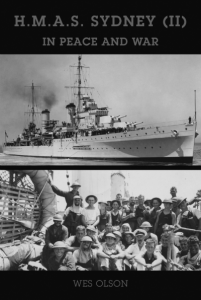- Author
- Book reviewer
- Subjects
- Ship histories and stories, History - WW2, Book reviews, Naval Engagements, Operations and Capabilities
- Tags
-
- RAN Ships
- HMAS Sydney II
- Publication
- June 2017 edition of the Naval Historical Review (all rights reserved)
By Wes Olson, Privately Published at Hilton, WA in 2016, 610 Pages with maps and photographs. Available direct from the author at email: wes.dale@westnet.com.au. Price $60.00 plus postage.

Aside from wartime publications such as 1941’s Grey Gladiator, books dedicated to the most famous of Australian warships, HMAS Sydney II, have predominately focused upon the contentious circumstances of her loss. Author Wes Olson arguably produced the genre’s most convincing work in Bitter Victory (2000). Olson’s hypothesis, that a ‘line of best fit’ could be drawn through German eye-witness evidence to explain Sydney’s defeat was a refreshing approach and one largely vindicated by the examination of her wreck in 2008.
Until now, Australian naval history has lacked a full account focusing on Sydney’s achievements and wider experience of the pre-war and early wartime navy. Olson’s HMAS Sydney II in Peace and War achieves a history easily accessible to the general reader as well as concise enough to appeal to the enthusiast and professional alike.
The 600 pages of the book are both well written and accurate as well as profusely illustrated with photographs; many of them published for the first time. Photos of Bartolomeo Colleoni, at full power and laying a smoke screen as salvos from Sydney fall around her, are particularly noteworthy. The narrative flows well and contains just enough ‘scene-setting’ information to place the political climate, as well as the operations the RAN was involved in, in context for 21st century readers unfamiliar with Second World War history.
The book is not written in the style of the recent crop of popular histories focusing upon the human experience of men at war and the families they left behind. The focusis firmly upon the ship although judicious use of diary entries has contributed towards this end. The level of detail, both in the operational handling of the ship as well as technical areas such as describing Sydney’s gunnery team in action, speak to a meticulous standard of research. Olson’s inclusion and exploration of more mundane activities adequately qualifies this work as a balanced appreciation of Sydney’s career. It also serves to impress upon the reader the true nature of active service at sea as well as what it took to maintain a ship’s effectiveness as a weapon system; namely drill, drill and more drill.
Olson’s handling of Captain Burnett’s performance in command of Sydney provides considerable insight into the Commanding Officer’s appreciation of the evolving nature of the war at sea. Despite the limited tools at the disposal of historians, the consideration of Burnett as a professional naval officer, whilst pulling no punches, is a well-balanced assessment that also offers a potential solution to the crucial question of his culpability in losing his ship.
Whilst Sydney’s final action is well described, anyone looking for an in-depth technical analysis should direct themselves to the easily accessible Cole Report of 2009. Similarly, there is no mention of the decades of controversy and conspiracy theories; an area this reviewer believes would have detracted from the book’s primary aim.
HMAS SydneyII in Peace and Waris a concise and wide-ranging history likely to become the preeminent general reference work covering the ship’s service career and, as far as this context is concerned, is unlikely to be surpassed.
Reviewed by Chief Petty Officer Peter Cannon




